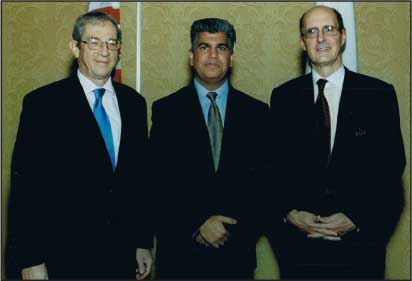Cohen & Talbott
Spotlight Security Issues in S. Asia
Los Angeles-The Asia Society and the
World Affairs Council jointly hosted a luncheon in Los Angeles
recently to focus on security issues in South Asia. It was
attended by 250 guests. Shezad Rokerya, Chairman of Interlink
Equity Capital, a private equity merchant bank and an active
investor in both Pakistan and India, chaired the discussion.
Rokerya spoke about his experience in both India and Pakistan
and the overarching need for the development of human capital
through bilateral co-operation. He also introduced both
speakers Stephen P. Cohen and Strobe Talbott.

(L to R):Stephen Cohen,Shezad Rokerya and Strobe Talbott |
Cohen
is a senior fellow at the Brookings Institution. He is the
author of several books on India and Pakistan. He has written
extensively on Pakistan and India. He was a member of the
Policy Planning Staff of the US Department of State and
before joining Brookings was a faculty member at the University
of Illinois. Talbott is president of the Brookings Institution.
He served as deputy secretary of state from 1994 to 2001.
For twenty-one years prior to his service in government,
he was correspondent and columnist for Time magazine. He
has written nine books, including The Russia Hand: A Memoir
of Presidential Diplomacy (Random House, 2002), a personal
account of US diplomacy toward Russia during the Clinton
administration. In his talk Cohen stated that in recent
years Pakistan has emerged as a strategic player on the
world stage — both as a potential rogue state armed with
nuclear weapons and as an American ally in the war against
terrorism. But our understanding of this country is superficial.
To
probe beyond the headlines, Stephen Cohen in his latest
book offers a panoramic portrait of this complex country—from
its origins as a homeland for Indian Muslims to a military-dominated
state that has experienced uneven economic growth, political
chaos, sectarian violence, and several nuclear crises with
its much larger neighbor, India. Pakistan’s future is uncertain.
Can it fulfill its promise of joining the comity of nations
as a moderate Islamic state, at peace with its neighbors,
or could it dissolve completely into a failed state, spewing
out terrorists and nuclear weapons in several directions?
‘The Idea of Pakistan’, Cohen’s latest book, will be an
essential tool for understanding this critically important
country. On May 11, 1998 , three nuclear devices exploded
under the Thar, or Great Indian Desert, shaking the surrounding
villages and the rest of the world. The immediate effect
was to plunge US-India relations, already vexed by decades
of tension and estrangement, into a new acrimonious standoff.
The situation deteriorated further when Pakistan responded
with a test of its own two weeks later.
Cohen indicated that Pakistan was very similar to Israel
in that it was created as a homeland for India’s religious
minority - the Muslims. In response to several questions
he stated that the current Corps Commanders in the Pakistan
military were very moderate. That radical Islamists do not
exist in the Pakistan army and the likelihood of the hijacking
of nuclear installations was improbable. He stated the US
policy agenda on Pakistan and India cannot isolate Pakistan
and that the US must work with the Europeans to develop
a continuous aid package of tough love and of rebuilding
schools. Engaging India is Talbott’s revealing, authoritative
account of the intensive talks that the United States conducted
on parallel tracks with the South Asian nuclear powers over
the next two and a half years.
Bill
Clinton’s point man for that high-stakes diplomacy takes
us behind the scenes of one of the most intriguing and consequential
political dramas of our time, reconstructing what happened
— and why — with narrative verve, rich human detail, and
penetrating analysis. From June 1998 through September 2000,
in the most extensive engagement ever between the United
States and India, Deputy Secretary of State Strobe Talbott
and Minister of External Affairs Jaswant Singh met fourteen
times in seven countries on three continents. They grappled
with the urgent issue of arms control and nonproliferation,
but they also discussed their visions for the US-Indian
relationship, the potential for economic and strategic cooperation
between the two countries, and the implications of Hindu
nationalism for the evolution of Indian society, politics,
and security. Their personal rapport helped raise the level
of trust between the two governments.
As a result, the United States was able to play a crucial
role in defusing the crisis between India and Pakistan over
the contested territory of Kashmir in the summer of 1999
— thus, perhaps, averting a war that could have escalated
to nuclear conflagration. The Talbott-Singh dialogue laid
the ground for Clinton’s transformational visit to South
Asia in March 2000. That presidential journey opened a new
chapter in relations between the United States and India.
It also set the scene for US cooperation with both India
and Pakistan in the war against terror after September 11,
2001. Talbott suggested that the LoC should be converted
to a boundary and higher autonomy be given to the Kashmiris.
The debate in India on Kashmir had gone further than in
Pakistan and he felt that outside assistance was needed
to help both countries’ relations. Pakistani business was
very pro-India as was shown by the successful exchange and
visits by the Young President’s Organization (YPO) in Karachi
and Goa. The issue of the Indian quest for a UN Security
Council would require India to do certain things that would
make the US more supportive, which he did not feel would
happen anytime soon.
-------------------------------------------------------------------------------------

